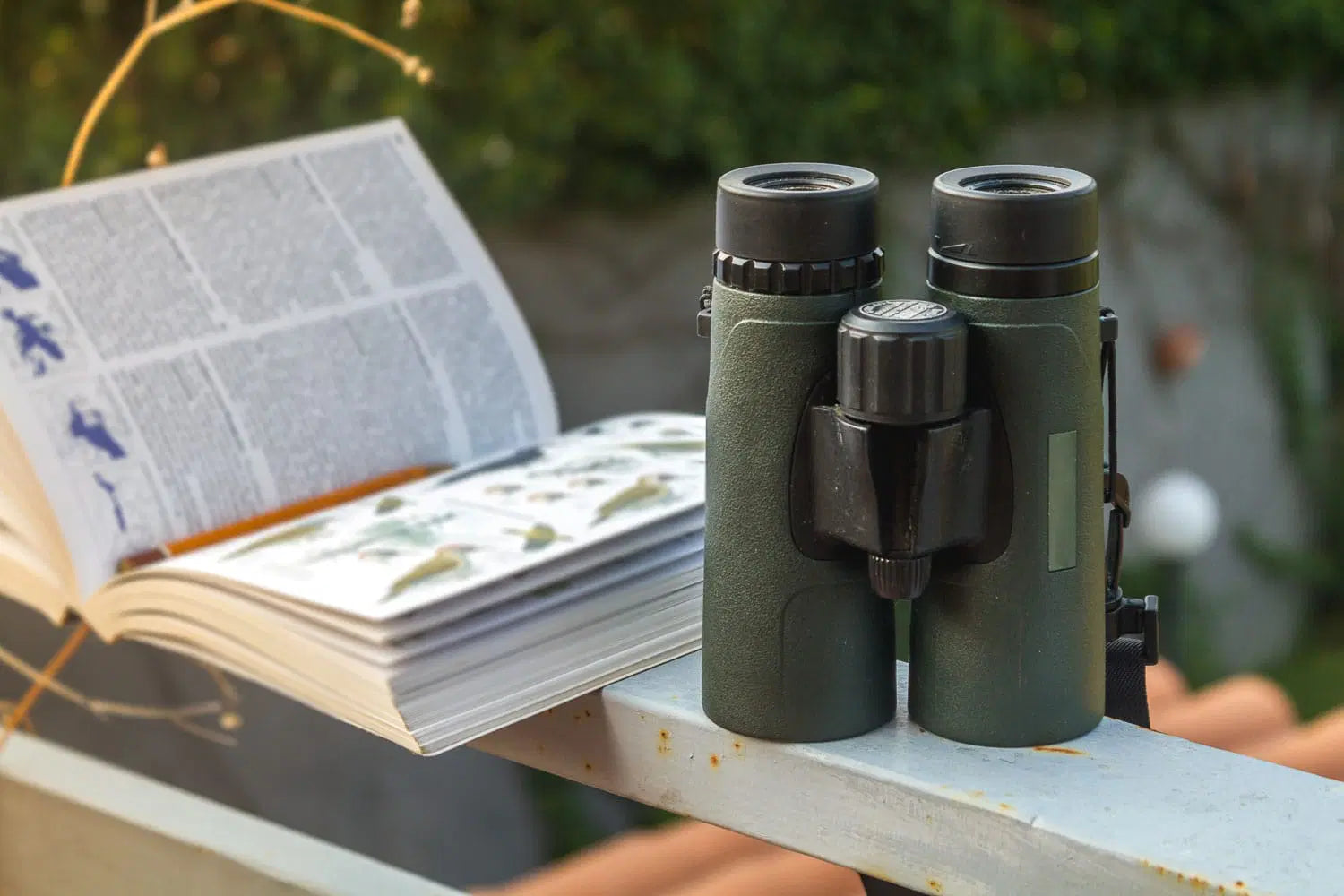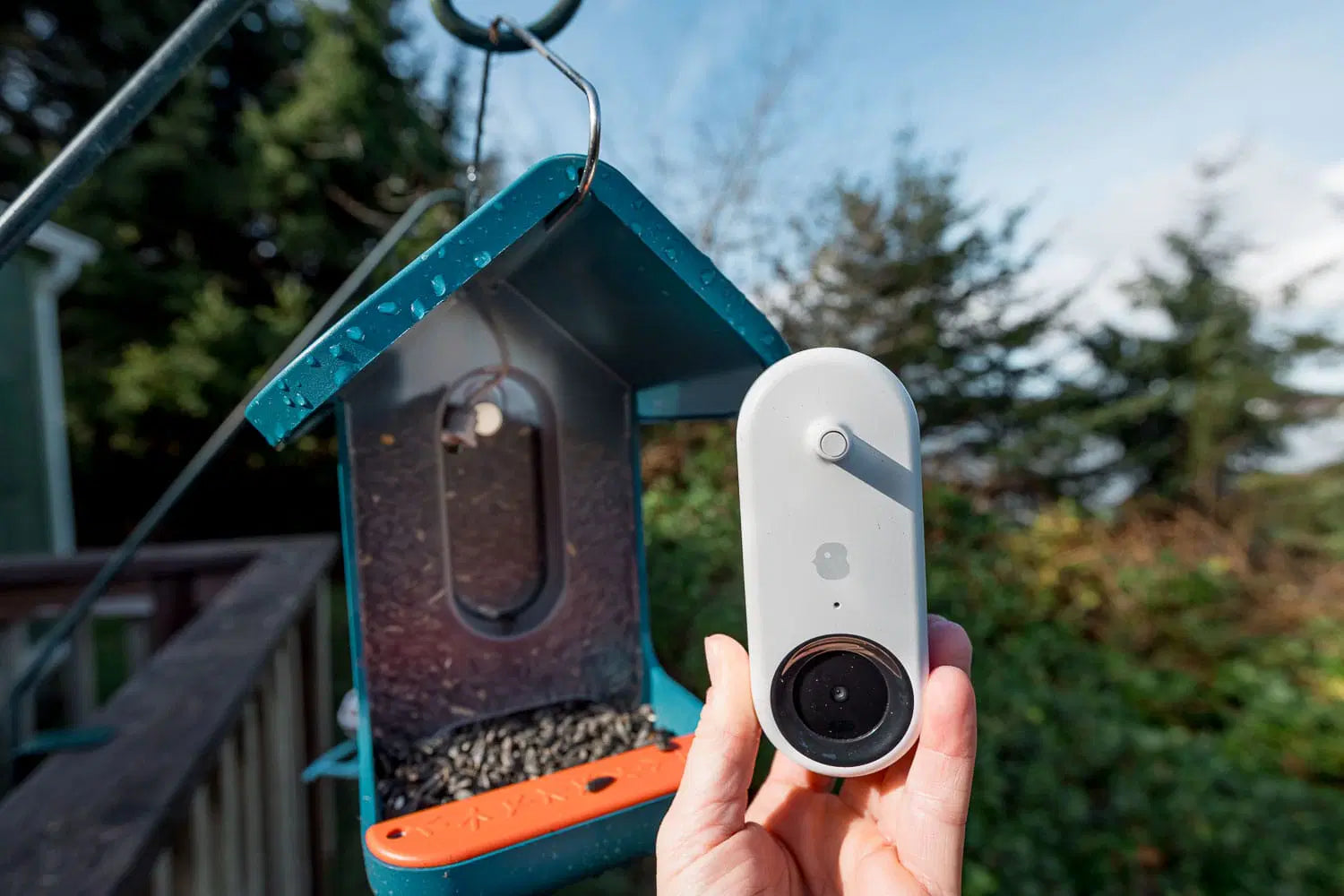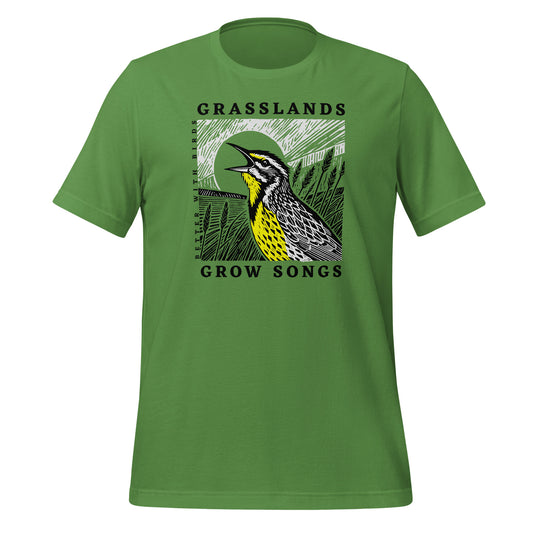How to Care for Your Binoculars for Lasting Performance
Feature photo: AI-generated silliness
Read Time: 11 minutes
Birding Gear , Binoculars & Scopes

This post contains affiliate links. If you use these links to buy something, we may earn a commission at no additional cost to you. We only recommend products we fully support or use ourselves. Our full disclaimer
PIN THIS FOR LATER

Contents
Learning how to care for your binoculars effectively can prevent damage and costly replacements. So, let’s hunker down for a crash course in binocular maintenance, complete with instructions for cleaning, storing, and handling your optics with care.
From wiping away fingerprints to safeguarding against moisture, we’re going to explore the delicate touches and devoted practices that keep the heart of your binoculars beating strong.
Because even the toughest of tools need some tender loving care.
And, pro tip: always consult the manufacturer’s manual before launching into any maintenance.

Here’s a photo of a cute pair of red-necked grebes to inspire you to keep your nocs clean for crystal-clear viewing. And also because we like to look at cute birds for no particular reason. I mean, that’s what we’re all here for anyway, right?
First things first: prevention is key!
What’s the saying: an ounce of prevention is worth a pound of cure. Well, that’s the case with binoculars too.
To best protect your binoculars, keep these tips in mind:
🐦⬛ Keep your binoculars stored in a secure carrying case with lens covers and caps securely in place when not in use.
Lens caps and covers are important as they protect lenses from dust, moisture, and scratches, helping to preserve their quality and performance.
Proper storage not only protects binoculars from dust, dirt, moisture, and potential damage, it also helps to reduce the frequency of cleaning required, which preserves the lens coatings and extends the lens’ lifespan.
🐦⬛ Store them in a dry and dust-free environment.
The right storage methods can make a world of difference in maintaining the life of your binoculars.
Think of moisture management and proper storage solutions as your binoculars’ insurance policies.
Using silica gel packs or other desiccants like small bags of rice in binocular cases can absorb excess moisture, preventing condensation and fungal growth.
The simple yet effective technique of storing binoculars upside down helps ensure that dust does not settle on the large objective lenses, which are more exposed when stored right-side up.
Reducing dust accumulation on the objective lenses can significantly improve the longevity and image clarity of binoculars.
🐦⬛ Lessen wear and tear by using protective measures like secure strapping and proper transportation.
Using a neck strap is essential for preventing accidental drops of the binoculars. When traveling with binoculars whether by plane, train, or automobile, binoculars are safest when they’re secured within their cushioned carrying case.
🐦⬛ Not only humans need to be sun-smart; binoculars do too!
Leaving binoculars exposed to direct sunlight can damage their internal components.
Excessive heat, such as in a hot car, can damage the coatings and adhesive that holds the prisms together in binoculars.
🐦⬛ Avoid touching the lens surface with your fingers.
🐦⬛ Handle them with care!
Avoid dropping or banging them against hard surfaces.
🐦⬛ And, clean the lenses regularly using a soft cloth or lens cleaning solution.

Oh look! Another cutie pie. This time a Japanese white-eye. Adorbs.
How to clean binoculars
While we believe that you’re going to take our advice and do everything possible to protect your binoculars, at some point they’re going to need to be cleaned.
So, let’s dive into the nitty-gritty of keeping your binoculars in tip-top shape. We’re going to walk you through the essential steps of cleaning your binoculars, ensuring that each component—from the lenses to the body—gets the TLC they deserve.
Let’s start by covering what you’ll need.
🐦⬛ Air blowers are used to remove larger bits of debris, particularly from tricky-to-reach places. As a non-contact tool, an air blower eliminates any risk of scratching the delicate surface.
🐦⬛ A microfiber cleaning cloth is perfect for wiping off the lens surface without damaging it. Known for their softness, absorbency, and ability to attract dust, microfiber cloths are the ideal type of cloth wipe for cleaning glass.
🐦⬛ A lens cleaning solution, which is specially formulated to be safe for camera lenses, can tackle more stubborn smudges without damaging the lens coating or leaving residue.
🐦⬛ A cleaning brush features soft bristles to remove dust and debris from the surface and hard to reach areas of your camera lens without causing any damage.
🐦⬛ A lens pen, or more specifically, a double-sided cleaning pen, features a soft bristle brush on one end and a non-liquid cleaning element (typically a flat, round pad) on the other end.
🐦⬛ Lens swabs are used for more detailed cleaning. They often come pre-moistened with a lens cleaning fluid and are typically intended as single use. These specially designed swabs are a much better option than, say, cotton swabs, which aren’t lint-free and could scratch the delicate surface.
|
The Stuff We Like To Use:
|
What you should NOT clean lenses with
Before going any further, a quick note on what not to clean your lenses with.
Do not let any of the following anywhere near your binocular lenses:
🐦⬛ Household cleaners, detergents, and soaps. These can be too harsh and may scratch and deteriorate the lens coating.
🐦⬛ Rough materials. Paper towels or tissues may seem convenient, but they’re too abrasive.
🐦⬛ Alcohols. High-concentration isopropyl alcohol or other denatured alcohols can damage the lens coating. Also avoid alcohol wipes as not only can the alcohol be damaging, so can the wipe material.
🐦⬛ Compressed air. While these cleaning powerhouses can do wonders in getting into the nooks and crannies of, say, your computer keyboard, they’re waaaaaaaaay too strong for cleaning binocular lenses.
🐦⬛ Anything not specifically developed for cleaning lenses. Stick to cleansers and materials specifically designed for lenses to keep your gear in top shape.

A little brain break brought to you by this gorgeous gal, a lovely hooded merganser.
Cleaning your binocular lenses
At the proverbial heart of binoculars are the lenses. Just like we protect our own heart (not proverbially-speaking this time, but, literally, like with heart-healthy foods and cardio), lenses need care and maintenance to keep performing their best year after year.
To safely clean your binocular lenses, use air blowers, lens brushes, and a gentle wiping motion, along with the right cleaning solution and a cotton swab or lens cleaning cloth for a thorough clean.
Follow these steps:
Step 1: To start, you’re going to want to clean binoculars while holding them upside down. This way any dirt or dust falls away and out rather than getting lodged into the crevices.
Step 2: Use an air blower (not compressed air) to gently remove particles of sand and grit to prevent them from scratching the lens surfaces during cleaning.
Step 3: Use a lens brush or a lens pen with soft bristles designed specifically for camera or optical lenses to remove any residual loose dust. This will be less likely to damage the lens coatings. Using those tools, gently sweep the brush or pen across the lens in a circular motion to lift any dust without putting pressure on the lens surface.
Step 4: Next, apply a small amount of a lens-approved cleaning solution onto a high-quality microfiber cloth or a lens cloth specifically designed for optical surfaces and without using too much pressure, gently wipe the lens in a circular motion.
Not to get too nitpicky, but try to hold the cloth by its edges to avoid transferring oils from your fingers onto the microfiber cloth.
Step 5: Finally, use a lens pen or lens swabs for stubborn smudges and fine detail cleaning.
And, one last thing – make sure the lens is fully dry before replacing the lens caps, then keep that cap on so that the lenses stays clean!
Cleaning the body and eyecups
Just because the binocular body is more durable than the lenses doesn’t mean it doesn’t need to be treated with care! Prior to wiping the binocular body, use a blower to dislodge loose particles of dust, then a damp cloth should be used to gently clean the binocular body.
For binoculars with removable eyecups, detach the eyecups then clean them separately with warm water to remove dust and debris, then re-attach them once they’re thoroughly dry.
For areas where the rubber has become sticky, a specific cleaning solution or water can be applied, and the areas should be gently rubbed to clean without causing further damage.

One last lemon-drop cheerleader to motivate you as you jump into advanced care techniques, because you DEFINITELY want fully functioning binoculars for viewing warblers like this Townsend’s warbler.
Advanced care techniques
Consider advanced care techniques as secret weapons in your binocular care arsenal. Performing these techniques can maintain binocular performance and significantly extend their lifespan.
Adjusting and tightening loose components
An essential part of advanced care involves adjusting and tightening loose components of your binoculars.
Cleaning the hinge mechanism is crucial to prevent the build-up of dirt and ensure smooth functionality.
If you find a loose hinge, you can adjust it by removing the end cap to access and adjust the spanner screw beneath it.
When hinges are loose, tighten them with a screwdriver, ensuring not to over-tighten as it can harm the binoculars.
Checking waterproof seals
Waterproof seals protect your binoculars’ internal components from moisture and fogging.
A thorough inspection of waterproof seals should include checking for potential damage or deterioration that might compromise the binoculars’ water resistance.
Maintaining these seals involves applying silicone grease periodically to keep them flexible and effective.
Regular inspection and maintenance of these seals can help to ensure that binoculars remain water-resistant over time, extending their lifespan and reliability.
Regular checks for alignment and functionality
Conducting regular checks for alignment and functionality is like giving your binoculars a routine health check-up.
To assess binocular alignment, attach them to a tripod and observe a distant object with straight lines, then compare the view of each eye for any discrepancies.
Misalignment in binoculars can be recognized by the appearance of double images or a sensation of dizziness when using them.
For the DIY enthusiasts, you can realign Porro prism binoculars by using two screwdrivers to adjust the prism aligning screws, making small movements until the images from both eyes align properly.
Regular maintenance really is about becoming your binoculars’ personal caretaker.

















